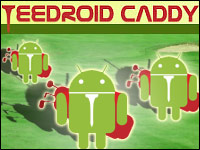
I’ve been using a T-Mobile G1 for about a month now, and while it’s the best phone I’ve ever owned (yes, I bought it), I haven’t yet found myself saying “I love this phone.”
I like it plenty, don’t get me wrong, but like any device, it’s got things about it that are frustrating and other things that are pretty cool.
The G1 is the first phone to use Google’s Android software stack, though by no means the last or the only. Others are said to be in the works from the likes of Motorola and LG. This one is an implementation of the HTC Dream.
Why Must There Be Killing?
It’s inevitable that the phone draws comparisons to the iPhone, though I would caution against considering this an “iPhone killer.” I’m perfectly happy knowing that it *isn’t* an iPhone, that I paid less up front, and I pay less each month for service.
To put it simply, if you want an iPhone, go get an iPhone. If you want something else, here’s one to consider. The main difference: G1 isn’t as sleek and beautiful. It has buttons and moving parts.
It’s got a touchscreen, with a plastic — rather than glass — surface. I consider this an advantage because if I ever drop my phone, the screen is much less likely to break. If it does break, it’s a whole lot cheaper to replace. And it weighs less.
To me, the Qwerty keyboard is one of the G1’s more attractive features. I’ve read more than one review that decries the “Leno chin” — that curved protrusion where the buttons and trackball sit. The main beef is that it gets in the way when you’re trying to type.
This is the first phone I’ve owned with a full keyboard, so I haven’t gotten used to typing on a Sidekick or other device whose keyboard spans its entire length. So, I didn’t have to unlearn and relearn the workings of the keyboard and the related hand positions. I just learned, and it’s not so bad.
The keyboard’s best function, by the way, is the little “@” button and the fact that it inserts apostrophes automatically in words like “I’ll.” What would be nice is something the iPhone has, and that’s a one-touch “.com” option. This is a flexibility that the touchscreen keyboard offers, but which a physical keyboard has more difficulty accommodating.
Sparse App Market
I’m a little frustrated with the Android Market, but I have a feeling that the issue will resolve itself soon. Allow me to explain: When I read many of the initial reviews, I noted that the reviewers lamented certain shortcomings (such as the lack of Outlook support and the absence of automatic orientation switching). Nearly everyone brushed off the concern by noting that “they’ll probably come out with an app pretty soon.”
It seems as if “pretty soon” has come and gone, and still there’s no Outlook support or orientation app — neither of which I really care about anyway, but it illustrates a point. The point is that some apps that you’re used to seeing on the iPhone won’t be staking a claim on Android until their developers can charge for them.
Google isn’t allowing paid applications onto the Android Market until early next year. Once that door opens, I’m pretty sure you’ll see lots of paid apps to supplement the free ones that are out there now. You might even see some that compete with functions the phone already offers.
I hope we do, in fact. I’d like to see a better music player, for one thing.
Headphone Headaches
Another feature that I’d like to see changed is the headset jack. This has probably been the chief complaint that reviewers have had with the G1, and I couldn’t agree more. The decision to go with a USB interface was, simply put, a bad one. It’s made worse by the lack of support for Bluetooth headphones.
The only option I have if I want to listen to music is to use the headphones that came with the unit, which are of the lopsided variety that wrap behind your neck, never stay put and need to be clipped to whatever you’re wearing. The microphone/volume/toggle button attachment is huge, heavy and ugly. Note to HTC: Change this feature — customers hate it.
I’ve also found the battery life to be short, but comparable to that of the iPhone 3G. Let’s face it, it takes a lot of power to run all those processors and radio chips, so I’m at peace with that one. Besides, when my battery gets old and worn out, I can recycle it and put in a new one.
The GPS function sometimes takes an unduly long time to get a lock on my position, which makes using my favorite app, CardioTracker, a challenge at times.
Much also has been made of the lack of multitouch. No, you can’t pinch or spread your fingers to zoom in or out, and that’s a bummer. I wouldn’t pass up this phone for want of that one feature, however.
Matter of Choice
It all comes down to what phone is best for you. If you want one that’s sleek, beautiful, flawlessly integrated, delicate and controlled by an iron-fisted vegan, go and buy an iPhone. It’s a great product.
If you want a one that’s a little more rugged and has a Qwerty keyboard, and a software and hardware ecosystem that’s built on open source principles, you won’t go wrong with a G1.
If you don’t like the G1, other Android phones will be along soon. Either way, you’re gonna get a good phone.



















































Jason, I share your sentiments about the G1; particularly lack of Outlook/Exchange support. I personally own the G1 and use MailShadow for Google Apps (MailShadowG), a solution that my company Cemaphore, developed to provide real-time bi-directional synch between Outlook/Exchange, Gmail/Google Apps, and the G1. So the people who thought "they’ll probably come out with an app pretty soon" were right. We released MailShadowG on Nov 17th.
If people want to find out more about MSG they can check it out on our Web site http://cemaphore.com/mailshadow_g.php or get a free 15-day trial.